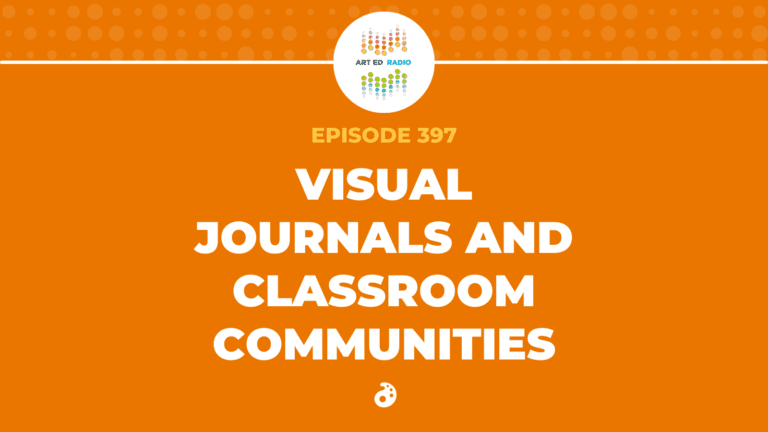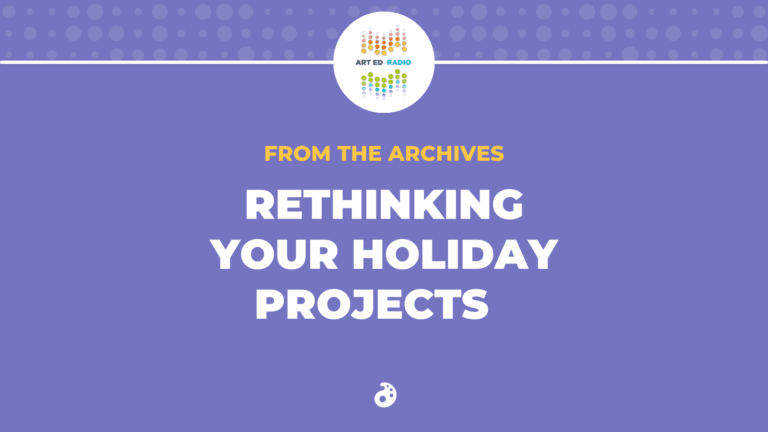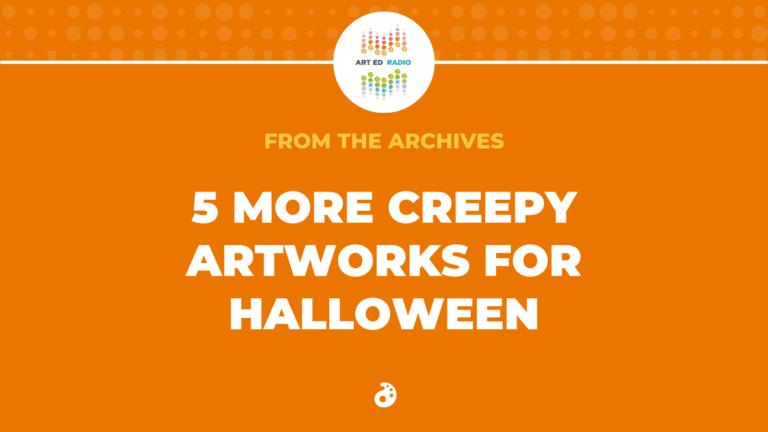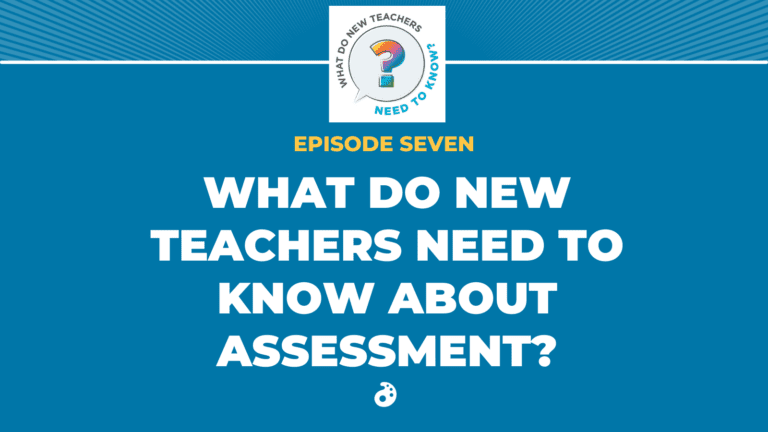Why would we want our students to think like artists when they could think like designers instead? Andrew talks about how to get students into this mode of thought by incorporating more design thinking and design curriculum in the art room. Kathryn Rulien-Baries, from the Wisconsin Visioneers program, joins Andrew to discuss modifications and alterations teachers can do right now to be more design inclusive. They talk about what makes design curriculum unique (6:45), art-making with a purpose (11:00), and whether art teachers are the most qualified to embrace design thinking (13:15). Full episode transcript below.
Resources and Links:
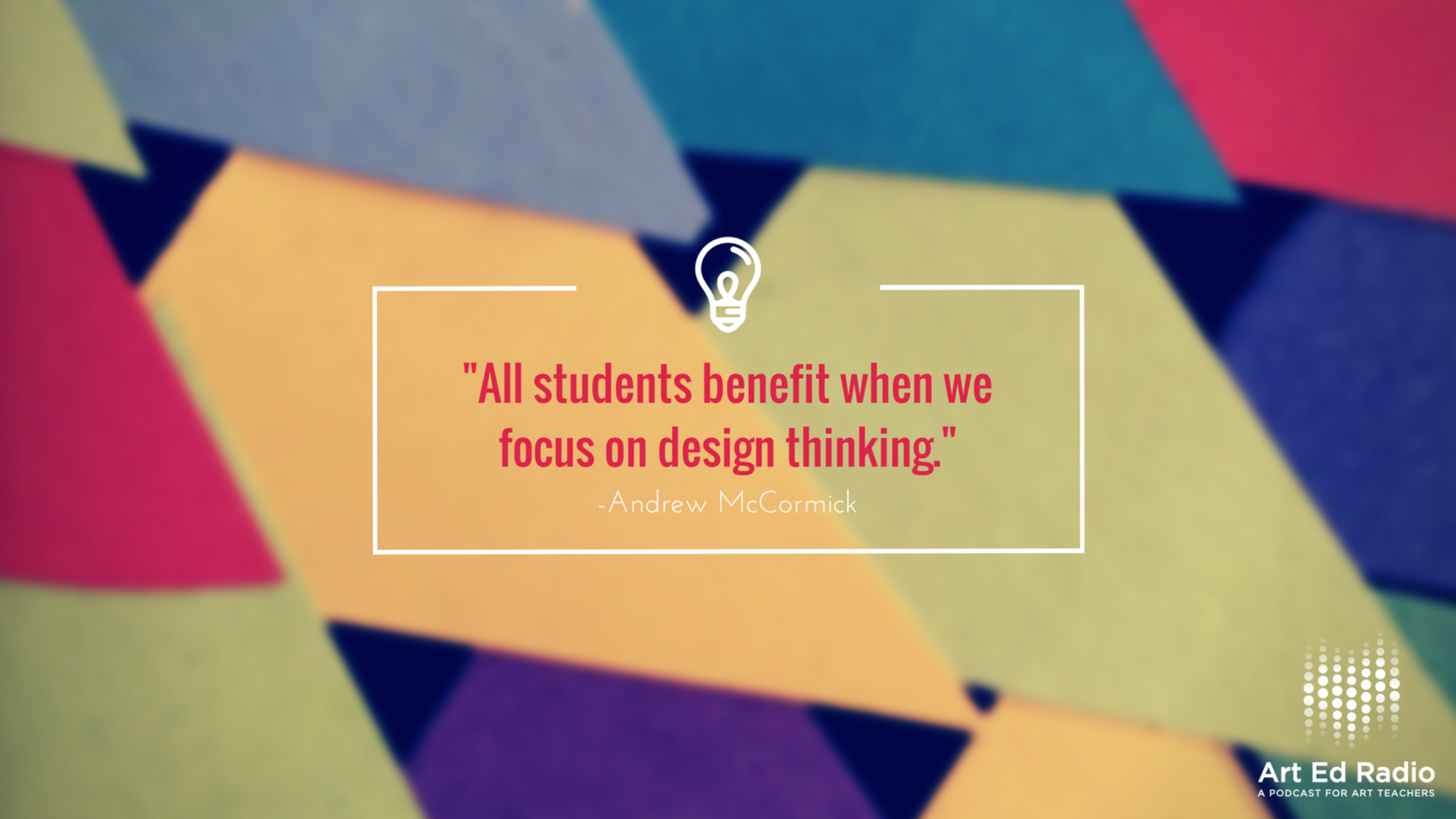
Transcript
Welcome to Art Ed Radio, the podcast for art teachers. This show is produced by art of education, and I’m your host, Andrew McCormick.
There is so much interest right now around choice in the art room. You know, whether it’s TAB, teaching for artistic behaviors, or studio habits of mine, or just thinking about a spectrum of choice. Shoot, I mean even the new national corps arts standards are pretty open-ended. With all these ways of looking at your curriculum, we keep hearing this idea: Get your students thinking like artists. Now while I love this idea, I’ve seen it take hold and I know firsthand that there’s a great deal that students can learn from thinking like an artist, I think it could be time to get our students to stop thinking like artists and start thinking like designers.
In today’s podcast, I’m going to bring out a great art teacher, Kathy Rulien-Bareis, and we’re going to talk about design thinking and design curriculum.
Kathy: I believe that importance of design thinking, it’s another layer to what we do in art education. It gives our students a sense of working with real world problems, and using their art skills to solve those problems.
Andrew: I first met Kathy at NAEA Chicago, where she shared the great program that the Wisconsin Art Education Association is putting on, the Visioneers Design Challenge.
My big realization in getting away from just thinking like artists and notice I said just, this isn’t an either or, I just want to be a little more inclusive of other ways of thinking too. This realization was pretty early on in my teaching when it dawned on me that I was making a huge mistake, and one that plenty of new teachers make. I was teaching to an idealized notion of a student who was much like I was as a teenager. Highly motivated in art, had some pretty strong abilities, probably going to go into art after school and study it and make it their career and life’s passion. We know that that is a super low percentage of our students that are probably going to fit that description.
Rather than focusing on treating our students like little future artists, I realized that all students, you know as future citizens, workers, contributors to society, consumers, benefit from having a really good grounding in good design. The practical side of design thinking and design curriculum is obvious: entrepreneurial spirit and branding are such big, new parts of this fast fluid economy that was created by globalization that everyone regardless of what career they end up going into is better for thinking about that stuff. Thinking about, how do I create things that better the world and still look really cook? They’re better for our thinking about how to solve real world problems while still wrestling with ideas of sustainability and community needs or niche demographics. How do I create and market a prototype of a product with a team of divergent thinkers from various backgrounds?
These sorts of questions are real world applications and they’re being touched upon by design-thinking curriculums that are put forward by programs like the Visioneers and other like-minded art teachers out there. I think that these types of questions and the subsequent rich student solutions and learning, those aren’t being asked and they’re not being answered if we exclusively get our students to think like artists.
I think this is our second episode focusing on design thinking. If you’re into this episode, definitely check out Art Ed Radio Episode Twelve with Ryan McInroy, where he and I talked STEM, STEAM, PBL, and a little bit of design thinking. You can hit up Artedradio.com and check out our past episodes. While you’re there, check out the course tab and check out some of AOE’s great courses like the Project-Based Art Room. Now this class is pretty new. I think it launched just this spring. It’s really great for all you STEAM-loving, maker-space spawning, design-thinking art teachers out there. In some ways, the class ties in nicely to the Art Ed Now conference talk I just gave a couple weeks ago about how to infuse your classroom with more of the Four C’s. Now if you missed that talk, shame on you, it was a good one. It was way better than Tim’s. But seriously folks, do yourself a favor and check out the Project-Based Art Room.
I know that Kathy is going to have some really unique perspectives on how design-thinking fits into this new PBL STEAM STEM four C’s thing that we’ve got going on, so let’s bring her on and hear from her.
So hi Kathryn, thanks for joining us tonight on Art Ed Radio. I first bumped into you at NAEA Chicago and I saw you doing some really interesting stuff and you are coming to us from the wonderful state of Wisconsin. You run a really interesting program. Can you tell us a little bit about that program?
Kathy: I’d love to, Andrew. I co-chair Visioneers Design Challenge with Johanna Peterson. This is our third year in doing the program. We started as art teachers bringing our students, and now we’re co-chairing it. It actually started about eleven years ago. Virgi Driscoll, one of our retired art teachers, it was her brain child. She truly was the visionary behind the program. It’s unique to our state. It’s for middle school and high school students. We’re able to collaborate and connect with designers in the areas of architecture, animation, digital photography, game design, graphic design, exhibit design, fashion design, point of purchase, product design, urban planning, video production, and web design. The program really runs in two parts for us. It starts out with the long-term challenge and then it also includes an onsite challenge. We work with designers around our communities. They create the challenges for our middle school and high school students. Our students choose the challenge. They may work as long as two or three months on this solution to the challenge, and that we call our long-term challenge. In April, we come together in Milwaukee. Our students share and defend their solutions to the challenges, but they’re also given an onsite challenge. That’s a little bit about it. It’s a huge program but that’s just kind of the tip of the iceberg.
Andrew: I was super intrigued and I loved talking to you because I’m a big fan of design-thinking and a more design curriculum. What do you think makes for a really quality design curriculum? What makes it so unique?
Kathy: I would say that anytime you talk about curriculum, I think it’s really important that it includes real world problems and obstacles in the area of design. Student research probably is the key. I did some work with Virgi Driscoll and Howard Gardner’s Project Zero, if you’re familiar with that from Harvard. Wisconsin brought it here, we called it Arts Propel. That’s kind of where Visioneers originated from. Again, our students need the art skills and the knowledge to work and solve these problems. In the world of design, the challenges should be part of our curriculum. You think about science and how science and our knowledge of the Solar System has changed. The world of design is going to continue to grow so I think that curriculum also has to be a living curriculum and has to include those changes.
Andrew: I just want to clarify something really quick. This program that you run, it’s kind of an after school or kind of club activity. It’s not something that teachers adopt as their entire curriculum?
Kathy: It’s … well, it’s kind of …
Andrew: Or is it up to the teacher that gets involved with it?
Kathy: Yes. Some of the teachers use the design challenges for part of their curriculum. I personally do not. I use it as a part of our gifted ed opportunities. We do discuss all of what the kids are working on in my regular classes, but because of the rigor that the students put on themselves, sometimes it’s best to do the work outside so that we aren’t confined to only forty-five minutes if that makes sense.
Andrew: Right.
Kathy: All the art educators that have worked with the program have really been able to learn about design right along with their students. I think that’s why we teach. We want to learn. Visioneers has brought our art departments into more visibility. We work with parents. We work with other teachers. We work with community members. Those connections and relationships that we build, that’s what really matters.
Andrew: Right. One of the things that I’ve been bumping up against a little bit as I’ve shifted included more design thinking and STEAM education and engineering solutions. Do you think that there’s teachers out there who fear adopting these sort of curriculum or lesson plans because they think it nudges out some of the tride and true art for art’s sake type projects?
Kathy: I see it as a perfect fit. All their students have to use their knowledge of the elements and principles of art. I agree, Visioneers is STEAM. I don’t think that we’re going to get rid of one thing in order to do another. I know everybody says, the time constraints, how can you do it all? We find ways to do it all. It’s very important for students to apply the knowledge, not only from our art room but all subject matters and bring it together. A lot of times their learning is linear, but I think in the real world of design, as well as entrepreneurship which I’m really passionate about, there’s so many directions that our learning takes us, so it’s really not in a straight line, just like our curriculum shouldn’t be in a straight line. We want our students to apply their knowledge in a real world work way, and Visioneers really does allow for this opportunity.
Andrew: Well, you’ve kind of gotten on the next question I was going to ask you. Maybe you can elaborate on it a little bit. Just like there’s teachers out there who maybe are a little worried about, well if I do this then this gets rid of, maybe to counterbalance that, what do you think students who are participating in Visioneers, or a similar design-thinking program, are getting that say maybe a kid in a more traditional principles and elements only curriculum would be getting? What are the students getting that’s unique?
Kathy: Again, I think it’s the connections, and it’s that we’re not making, and I want my students to make beautiful art, but we’re not necessarily making just that beautiful art. That art has purpose. When you think about product design, I had a student that designed new tools for possibly elderly people. They’re lightweight to use in the garden, and maybe you can use them a couple different ways and they’re easy to clean. To think about products that we use, even everyday, look at how they’re designed and how can you redesign them to make them better? Our kids are really excited about making a difference, really making a difference in the world. I think that’s what our design thinking is about. It really makes them understand how art fits within the world. It isn’t just a piece of artwork that goes under glass. It isn’t something that you sit back and say, isn’t that beautiful? It’s functional.
When I taught elementary, we always had a lesson on form, fallace, function, and how do you design functional pieces. A lot of the time we did furniture. Our kids get really excited about, how is somebody really going to use this? How they are going to interact with it, even more than say how beautiful it is?
Andrew: We’ve talked a little bit about that the teachers in these programs, again whether it’s Visioneers or any similar design thinking, they’re getting the same skill sets from as the students, the connections, the entrepreneurship, seeing their learning is not just linear, but all the connections in between it. I’m going to go off on a side tangent here. Do you think that the art teachers in the building are the best fit for adopting that entrepreneurial STEAM, multiple connections, not linear thinking, or are we just one of many teachers that can do it as well?
Kathy: I always say that some of the most creative people in our building are art teachers because they’re never looking for one answer, they’re looking for many, and obviously design thinking is about that as well. We can see connections probably easier than other teachers can as well. When we’re working with Visioneers, in fact, I really encourage my students to go talk to Tech Ed teachers and I encourage them to go into family consumer ed and talk to those teachers because I don’t have all the answers. I think that’s the other thing that design thinking is about is you don’t have to have all the answers, you’re going to have to do some research. You’re really going to have to go out and dig deeper. Many times in our classroom, and again I’m guilty of this because of constraints within the time that I have the kids, I provide them with probably more information than I should. Not all the information that I have is the best information. I’ve learned an awful lot to my work in Visioneers over the last eleven years. It’s pretty amazing. I’m not sure if I answered your question because I started to go off on another tangent. You got me all excited about something.
Entrepreneurship too does fit in really well with design thinking because again, we’re giving our kids some opportunities to test out, get their feet a little bit wet, especially at a middle school level. This is incredible because I think this is when we can really capture them and get them excited about a specific career opportunity. Whether it’s about designing even their own company that works with some of the ideas that they’ve done. For example, one success story of one of my students, she did fashion, she did photography. She know has her own photography company, and she’s doing really remarkably well. Her business, and I’d like to think that some of the work that she did with us in Visioneers compelled her to start her own company, her own business.
Andrew: You made me think of something that a lot of schools will boil down to the aside of core curriculum versus an elective or special curriculum and to some degree that kind of drives me crazy because that kind of pits half of the building against the other half. At my former school, we all the elective teachers we were feeling a little under pressure, undersized, and undervalued, and all this stuff, so we actually came up with a slogan that I think fits into this thought pretty well, and it said “Today’s electives are tomorrow’s careers.” I just think about what you said about middle school younger high school really is this fertile ground for students discovering what their interests and what their passions are and then those kind of turning into then what they make their life’s work about which is really fantastic.
Kathy: You just mentioned probably the most important word of all, where it’s discovery. That’s what design is about. It’s that finding things and finding things that other people haven’t found. I think that creative peace is so important for everyone, for our whole world actually. The community connections have been another part that’s been really incredible. I hear a lot of teachers saying, “Oh, my program is cut. I’m worried about this. I’m worried about money.” We really need to be visual and people need to see our students doing some remarkable things. No school can cut a program when it’s doing remarkable things with their students’ education.
Andrew: If there are some listeners out there and they want to start taking baby steps to be more inclusive of design thinking, what are some simple things that you think that they could start doing to bringing some of that curriculum into their classroom?
Kathy: In this we go across the board I think any age level. Product design, of course that’s my passion, but product design would be remarkable. There’s so many different ways you can do it. Have your kids find an obstacle. Don’t find it for them. They know those obstacles are out there. It could be within your classroom, it could be an art material, it could be within your school or your community. Maybe something that your students find is really frustrating, like how the water fountain works. Mine were my sinks in my classroom, and students helped redesign so that we were able to actually fix our sinks so that they work better. They function for our kids. I had them redesign that product, that idea, to function better. Now they’re going to have to consider how people are going to use it, the cost, feasibility, and again that usability. I’ll tell you, giving kids that power for their learning is going to be incredible.
Urban planning is a pretty easy one. Have students look at a playground if you’re elementary, or a possible a community park for your middle school, high school kids and have them find a way to redesign it, and possibly with green materials, maybe even funding. How are you going to find funding for it? Kids are so excited about having opportunities like this. They’ll really get into the research. Again, they’re going to have to do some research, they’re going to work about the feasibility again too and the usage.
Architecture, you could go in and look at how your school is being run, and see if you can figure out a way to be more green. Maybe you start within the cafeteria. I know schools have already done this. How is the cafeteria set up to be more green? That could be part of an architecture unit.
Some things you could spend a day on discussing. Some things you could spend a couple days on. I think too you’re going to find some kids will take it to their school council, student council and say, “okay we’ve got to make this change.”
Fashion design is another one. My kids did some design that “Modest is Hottest,” and I’ll tell you from middle school, that’s a pretty big jump for some of my kids because they like to show their underwear for some reason. Materials also, I think you do some research on materials that clothing is made from. One of my favorite materials is cotton, but I never knew until my kids researched, never knew in my wildest dreams, the cotton industry is really rough on your environment. Maybe having do some research and find out better materials for our clothing to be created from.
Andrew: Those are really, those are awesome ideas and I think what I like about them is just how engrossing they are. There’s math, there’s science, there’s research, they’re crunching numbers, there’s doing research, but they’re not doing it in an abstract way. It’s a real world problem that needs a solution.
Kathryn, I want to ask you really quick. Do you have a preference of someone out there kind of looks up the Visioneers program, can people, would you prefer that people adopt it hook, line, and sinker, or can people pick and choose and take some of the lessons and some of the ideas from it?
Kathy: We, that was the reason why you met me at Nationals in Chicago, we want to share this with everyone. We would like everyone to be able to see the successes that our students have had and we would love to provide them with information and it’s through the Wisconsin Art Education Association. We do have a link off the website, and definitely Johanna and I want to share as much as we can. Contact us through the website and we’ll get you as much material as we can possibly share with you.
Andrew: Well, all right. Thank you Kathryn. I’ll make sure that when this podcast goes out that we’ll provide the link to that so people can check it out.
Kathy: Oh, that would be great. Thanks Andrew.
Andrew: Thanks Kathryn, we’ll talk to you later.
Kathy: Okay, thank you.
Andrew: All right, thanks to Kathy for coming on. I was jotting down some notes the whole time during our talk, and I kept coming back to a few things that Kathy said. Discovery, connections, and relevance. With the design-thinking curriculum, our students discover their own solutions to complex, real world problems. In doing so, they have to connect with their community and connect the dots of what they’re learning in all these weird segmented classes.
Real learning isn’t so divided, designers pull from all sorts of academic disciplines. This is what I’ve always loved about bringing design thinking into the art room is that creativity, which we should be the natural experts in teaching and modeling, takes the forefront of importance. Not just in your classroom, but this creativity can really take hold in the entire school, and even in the entire school district’s culture, and who wouldn’t want that?
Art Ed Radio is developed, produced, and supported by the Art of Education with audio engineering by Michael Crocker. If you’ve been enjoying what Tim and I have been doing with this show, do yourself a favor and head on over to artedradio.com and click the I’m A Fan button and you’ll be added to our email list to receive updates on new podcasts, cool guests, and even some possible A of E discounts coming up. New episodes of Art Ed Radio are released every Tuesday, and additional content can be found on the podcast tab at the artofed.com. All right, thanks for listening.
Magazine articles and podcasts are opinions of professional education contributors and do not necessarily represent the position of the Art of Education University (AOEU) or its academic offerings. Contributors use terms in the way they are most often talked about in the scope of their educational experiences.
